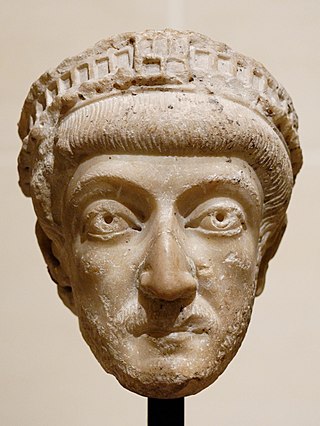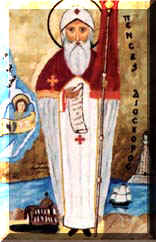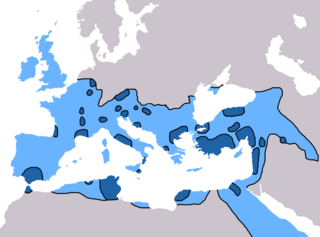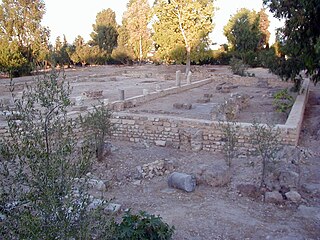In church history, the term acephali has been applied to several sects that supposedly had no leader. E. Cobham Brewer wrote, in Dictionary of Phrase and Fable, that acephalites, "properly means men without a head." Jean Cooper wrote, in Dictionary of Christianity, that it characterizes "various schismatical Christian bodies". Among them were Nestorians who rejected the Council of Ephesus’ condemnation of Patriarch Nestorius of Constantinople, which deposed Nestorius and declared him a heretic.
Pope John II, born Mercurius, was the Bishop of Rome from 2 January 533 to his death. As a priest at St. Clement's Basilica, he endowed that church with gifts and commissioned stone carvings for it. Mercurius became the first pope to adopt a new papal name upon his elevation to the office. During his pontificate, John II notably removed Bishop Contumeliosus of Riez from his office, convened a council on the readmission of Arian clergy, and approved an edict of emperor Justinian, promulgating doctrine opposed by his predecessor, Pope Hormisdas.
Pope Silverius was bishop of Rome from 8 June 536 to his deposition in 537, a few months before his death. His rapid rise to prominence from a deacon to the papacy coincided with the efforts of Ostrogothic king Theodahad, who intended to install a pro-Gothic candidate just before the Gothic War. Later deposed by Byzantine general Belisarius, he was tried and sent to exile on the desolated island of Palmarola, where he starved to death in 537.

Year 535 (DXXXV) was a common year starting on Monday of the Julian calendar. At the time, it was known as the Year of the Consulship of Belisarius without colleague. The denomination 535 for this year has been used since the early medieval period, when the Anno Domini calendar era became the prevalent method in Europe for naming years.

The Council of Ephesus was a council of Christian bishops convened in Ephesus in AD 431 by the Roman Emperor Theodosius II. This third ecumenical council, an effort to attain consensus in the church through an assembly representing all of Christendom, confirmed the original Nicene Creed, and condemned the teachings of Nestorius, Patriarch of Constantinople, who held that the Virgin Mary may be called the Christotokos, "Christ-bearer" but not the Theotokos, "God-bearer". It met in June and July 431 at the Church of Mary in Ephesus in Anatolia.

The Second Council of Constantinople is the fifth of the first seven ecumenical councils recognized by both the Eastern Orthodox Church and the Catholic Church. It is also recognized by the Old Catholics and others. Protestant opinions and recognition of it are varied. Some Protestants, such as Calvinists, recognize the first four councils, whereas Lutherans and most Anglo-Catholics accept all seven. Constantinople II was convoked by the Byzantine Emperor Justinian I under the presidency of Patriarch Eutychius of Constantinople. It was held from 5 May to 2 June 553. Participants were overwhelmingly Eastern bishops—only sixteen Western bishops were present, including nine from Illyricum and seven from Africa, but none from Italy—out of the 152 total.

Theodosius II was Roman emperor from 402 to 450. He was proclaimed augustus as an infant and ruled as the Eastern Empire's sole emperor after the death of his father, Arcadius, in 408. His reign was marked by the promulgation of the Theodosian law code and the construction of the Theodosian Walls of Constantinople. He also presided over the outbreak of two great Christological controversies, Nestorianism and Eutychianism.
Pope Vigilius was the bishop of Rome from 29 March 537 to his death. He is considered the first pope of the Byzantine papacy. Born into Roman aristocracy, Vigilius served as a deacon and papal apocrisiarius in Constantinople. He allied with Empress Theodora, who sought his help to establish Monophysitism, and was made pope after the deposition of Silverius. After he refused to sign Emperor Justinian I's edict condemning the Three Chapters, Vigilius was arrested in 545 and taken to Constantinople. He died in Sicily while returning to Rome.

Dioscorus I, also known as Dioscorus the Great, was the pope of Alexandria and patriarch of the See of St. Mark who was deposed by the Council of Chalcedon in 451. He was recognized as patriarch by the Coptic Church until his death. He died in Gangra, Paphlagonia, in September 454. He is venerated as a saint by the Coptic and other Oriental Orthodox Churches.
Domnus II was the Patriarch of Antioch between 442 and 449 and a friend of the influential Bishop of Cyrrhus, Saint Theodoret.
The Schism of the Three Chapters was a schism that affected Chalcedonian Christianity in Northern Italy lasting from 553 to 698 AD and in some areas to 715 AD, although the area out of communion with Rome contracted during that time. It was part of a larger Three-Chapter Controversy that affected the whole of Roman-Byzantine Christianity.
The Three-Chapter Controversy, a phase in the Chalcedonian controversy, was an attempt to reconcile the non-Chalcedonians of Syria and Egypt with Chalcedonian Christianity, following the failure of the Henotikon. The Three Chapters that Emperor Justinian I anathematized were:
- The person and writings of Theodore of Mopsuestia
- Certain writings of Theodoret of Cyrus
- The letter of Ibas of Edessa to Maris

Theodore of Mopsuestia was a Christian theologian, and Bishop of Mopsuestia from 392 to 428 AD. He is also known as Theodore of Antioch, from the place of his birth and presbyterate. He is the best known representative of the middle Antioch School of hermeneutics.
The Agnoetae or Themistians were a Monophysite Christian sect of Late Antiquity that maintained that the nature of Jesus Christ was like other men's in all respects, including limited knowledge despite being divine.
The Second Council of Ephesus was a Christological church synod in 449 convened by Emperor Theodosius II under the presidency of Pope Dioscorus I of Alexandria. It was intended to be an ecumenical council, and it is accepted as such by the miaphysite churches but was rejected by Chalcedonian Christians. It was explicitly repudiated by the next council, the Council of Chalcedon of 451, recognised as the fourth ecumenical council by Chalcedonian Christians, and it was named the Latrocinium by Pope Leo I; the Chalcedonian churches, particularly the Roman Catholic and Eastern Orthodox communions, continue to accept this designation, while the Oriental Orthodox repudiate it.

In the history of Christianity, the first seven ecumenical councils include the following: the First Council of Nicaea in 325, the First Council of Constantinople in 381, the Council of Ephesus in 431, the Council of Chalcedon in 451, the Second Council of Constantinople in 553, the Third Council of Constantinople from 680–681 and finally, the Second Council of Nicaea in 787. All of the seven councils were convened in what is now the country of Turkey.

In 6th-century Christianity, Roman Emperor Justinian launched a military campaign in Constantinople to reclaim the western provinces from the Germans, starting with North Africa and proceeding to Italy. Though he was temporarily successful in recapturing much of the western Mediterranean he destroyed the urban centers and permanently ruined the economies in much of the West. Rome and other cities were abandoned. In the coming centuries the Western Church, as virtually the only surviving Roman institution in the West, became the only remaining link to Greek culture and civilization.
Gaianus was the Patriarch of Alexandria for three months in 535.
Jus antiquum is a period in the legal history of the Catholic Church, spanning from the beginning of the church to the Decretum of Gratian, i.e. from A.D. 33 to around 1150. In the first 10 centuries of the church, there was a great proliferation of canonical collections, mostly assembled by private individuals and not by church authority as such.

The Archdiocese of Carthage, also known as the Church of Carthage, was a Latin Catholic diocese established in Carthage, Roman Empire, in the 2nd century. Agrippin was the first named bishop, around 230 AD. The temporal importance of the city of Carthage in the Roman Empire had previously been restored by Julius Caesar and Augustus. When Christianity became firmly established around the Roman province of Africa Proconsulare, Carthage became its natural ecclesiastical seat. Carthage subsequently exercised informal primacy as an archdiocese, being the most important center of Christianity in the whole of Roman Africa, corresponding to most of today's Mediterranean coast and inland of Northern Africa. As such, it enjoyed honorary title of patriarch as well as primate of Africa: Pope Leo I confirmed the primacy of the bishop of Carthage in 446: "Indeed, after the Roman Bishop, the leading Bishop and metropolitan for all Africa is the Bishop of Carthage."







